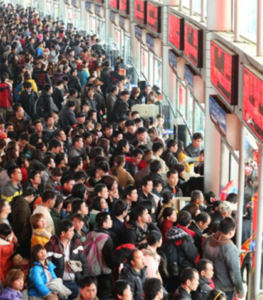Largest human migration event underway
China’s annual Spring Festival migration – the largest mass human movement on the planet – and this year will see people make 3 billion trips
Bringing much of China’s economy to a halt and straining its transport systems, the annual travel fest also coincides with the lunar New Year
 Called “Chunyun”, the 40-day period sees Chinese people head home to celebrate with their families.
Called “Chunyun”, the 40-day period sees Chinese people head home to celebrate with their families.
Among the migration will 2.5 billion trips will be made by care, 440 million by rail – a rise of 8.3 per cent – and 79 million by air.
There will be more than 17,000 flights a day on average, an increase of about 13 per cent from 2019. The new Daxing airport in south Beijing is expected to handle 1.9 million trips
In any other nation, this many travellers would grind local infrastructure to a halt.
The Chinese will spend more than $US100 billion on eating and shopping and buying railway tickets online at a rate of more than a thousand second.
But this year – the Year of the Rat – may be one of the last great migrations.
The outbreak of an avian flu in China and fears of infection may put a dent in the numbers travelling.
Extra precautions have been taken this year. Transport hubs have strengthened disinfection, monitoring and prevention measures
Also, China’s economic boom was built on the back of migrants, who began arriving in the major cities a decade ago seeking a slice of the country’s new found wealth.
But flat-lining wages and the relocation of many factories overseas as raised uncertainty for many migrants, thousands of whom are returning to the villages and rural areas they came from.
China’s economic problems have particularly affected migrants to its cities.
About 280 million Chinese have migrated from the rural villages to work in China’s modern cities, leaving their children thousands of miles away in pursuit of tougher work, but higher wages.
Strict rules on housing registration has resulted in more than 60 million “left behind children” living with their grandparents or other relatives – a price that migrants are willing to pay in return for the prospect of a brighter future.
But that current status quo seems doubtful as China’s economy grew by only 6.4 per cent in 2018, the slowest since 1990.
The average salary for migrants is about 3,000 yuan, or $US436, a month, according to official statistics, but wage growth has slowed from 21 per cent in 2011 to just 7 per cent in 2017.
It is estimated to have fallen even further in 2018, according to a survey of experts by Bloomberg.
Meanwhile, many factories have shipped their production to countries with cheaper labour costs, such as Cambodia or Vietnam.
The rising cost of living in China’s booming coastal cities is also forcing migrants to consider working locally, and recent figures suggest more than half find jobs in their home provinces.












